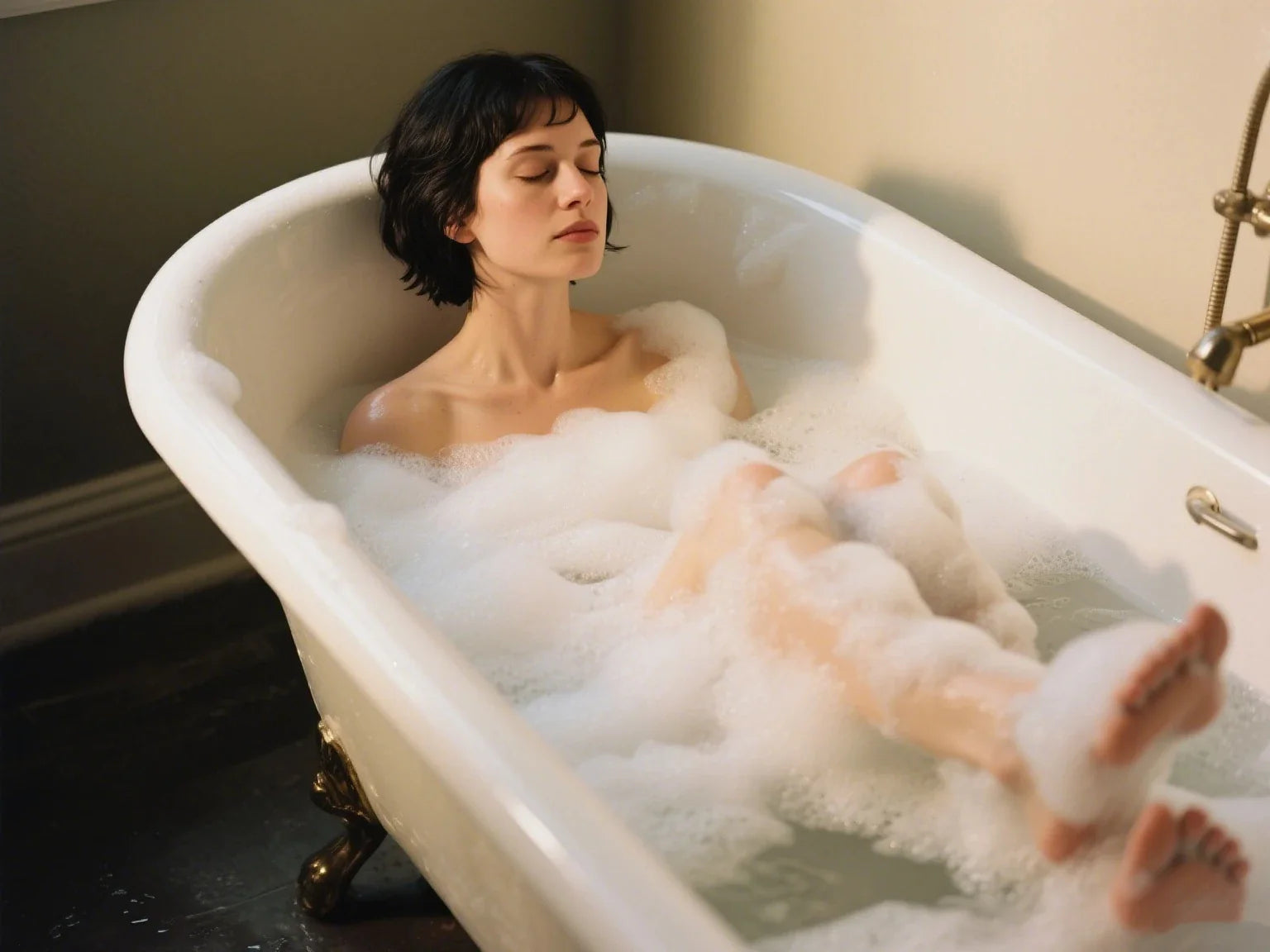A bathroom functions beyond its practical purpose to become a peaceful haven which provides both relaxation and restoration and comfort. The bathtub stands as a fundamental design element which defines this space. Homeowners who want both functionality and elegance in their bathrooms now prefer the drop in bathtub design among all available bathtub options. This article provides complete information about selecting the perfect drop in bathtub together with its characteristics and evaluation against other designs and its compatibility with your design choices.
Understanding the Drop In Bathtub: Definition and Core Features
The evaluation of a built-in bathtub for your bathroom requires knowledge about its definition and its distinctions from other bathtub types. A recessed tub features a rim which rests on a built-in frame or deck structure. The tub fits into a pre-constructed structure, so only the rim remains visible. The design provides bathroom owners with more freedom to arrange their space while enhancing visual appeal.
The Mechanics Behind Drop In Tubs
The installation method sets the drop in bathtub apart. The tubs do not stand alone as freestanding units because they need to be placed inside a raised platform or surround which is typically tiled or finished with another material to match the bathroom design. The enclosure functions as both a support system for the tub and creates space for storage or decorative elements.
The built-in bathtub remains the preferred choice for many homeowners because of its adaptable design. The drop in bathtub provides design integration with cabinetry, tile, and shelving because it does not require independent placement like freestanding bathtub or standalone tub that needs extensive floor space. The bathtub with deck surround unites with the room design to create a harmonious aesthetic that matches the surrounding decor.
Aesthetic Versatility and Design Freedom
The custom nature of surround construction enables built-in bathtubs to fit various bathroom design styles. A drop in tub can be adapted to match any design style from modern to traditional to eclectic. A built-in bathtub differs from a self-standing tub because it can either fade into the background or take center stage through decorative tiling or stone finishes.

Pros and Cons: Is a Drop In Bathtub Right for You?
Choosing the option involves weighing the advantages against the disadvantages carefully when considering drop in bathtubs—despite their numerous benefits they come with certain limitations as well.
Advantages of Drop In Tub
Many homeowners are attracted to the cohesive appearance of a bathtub with deck surround because of its versatile design options that can suit both subtle and striking preferences alike. Moreover , additionally, it typically provides upkeep around the edges since there are fewer visible seams to contend with.
When it comes to pricing differences between drop in tub option and high end freestanding bathtub made of materials like acrylic or fiberglass may favor the former due, to their lower base price point range.
A key advantage is the ability to trap heat effectively in a drop in tub due to its enclosed design compared to a freestanding tub which helps in keeping your bath warm, for periods and saves energy too.
Disadvantages of Drop In Tub
While drop in bathtubs offer benefits they may not be suitable for every homeowner. A prevalent issue is the need for space for the surrounding deck, which can make them less practical, for compact bathrooms, where a self standing tub or a smaller freestanding tub could make better use of the limited square footage available.
The installation process requires additional effort. The process of building the deck and securing the tub and finishing the enclosure demands more time and resources than installing a freestanding tub in an open area. The plumbing access becomes restricted during repair operations which makes the process more complicated.
Comparing Drop In Bathtubs with Other Tub Styles
The selection process of a bathtub requires evaluation against other widely used alternatives. The comparison between drop in bathtubs and alcove and undermount and freestanding bathtubs will be evaluated in this analysis.
Drop In vs. Alcove Tubs
An alcove tub is fitted between three walls and often includes a built-in shower. It is practical for compact spaces, but it lacks the design flexibility of a drop in tub. The soaking drop-in tub can be oriented any way and doesn’t rely on wall placement.
Drop in bathtubs provide designers with more opportunities to customize their appearance. The deep drop-in bathtub design functions better in master baths and spa-style retreats instead of the alcove tub which suits functional family bathrooms better.
Drop In vs. Undermount Tubs
The undermount tub design resembles deep drop-in bathtub because it conceals its rim beneath the surrounding deck. The design creates a smooth look but requires advanced installation techniques and increased expenses. The drop in tub design features an exposed lip which simplifies both installation and maintenance processes.
Both options deliver equivalent soaking experiences yet the drop in bathtub stands out for its accessibility and easier maintenance. The undermount design restricts access to the top area which creates difficulties for cleaning and plumbing maintenance.
Drop In vs. Freestanding Tubs

The visual appeal of freestanding bathtubs makes them highly popular. Luxury bathrooms feature these tubs as their central design element. These tubs require extensive space and complex plumbing systems for installation.
The built-in bathtub design takes up less space than a freestanding bathtub. The built-in design of this tub enables users to place storage and shelving units in the surrounding area for practical bathroom use. The drop in tub fits better into contemporary bathroom spaces which combine multiple functions while the self standing tub draws attention as a standalone piece.
Installation Considerations for Drop In Bathtubs
The selection of a drop in bathtub depends heavily on proper installation which needs thorough planning and specialized execution. A drop in tub requires a dedicated frame or platform for secure placement because it cannot be installed directly on the floor like a standalone tub or free standing bathtub. The installation process for drop in tub requires extensive work because it needs a precise method to achieve both operational success and visual appeal.
Pre-Installation Planning
The evaluation of bathroom layout compatibility for raised deck or enclosure installation should be done before buying a built-in bathtub. The evaluation process requires exact measurements of available space and tub height and dimensions and clearance requirements around the area. The platform structure needs to be designed to bear the weight of the drop in tub both when it is empty and when it is full of water and a person is using it.
The accessibility of plumbing systems represents an essential factor to consider. The plumbing lines need proper routing for future maintenance access while remaining hidden from view to achieve a clean appearance. It is highly advisable to consult with a professional contractor during the initial planning phase. They will evaluate the possibility of installing a drop in bathtub in your space while offering guidance on structural reinforcements and verifying that the installation will comply with local building codes.
The selection of materials for the deck or frame structure determines the final outcome. The frame of the platform typically uses wood because it provides strength and easy construction methods but the outer finish can be made from various materials. The selection of tile, granite, quartz or marble finishes for bathroom platforms allows users to choose from various design options at different price levels. The selection of premium materials leads to better bathroom design while providing long-term durability and moisture resistance.
The installation plan requires safe electrical wiring integration for tubs that include features such as whirlpool jets or air massage systems. The additional complexity requires professional installation to meet safety regulations.

The Installation Process
The process of installing a drop in bathtub requires multiple precise steps which need skilled execution. The first step requires building a supporting frame or deck according to precise specifications which will serve as a stable base for the tub. The plumbing and drainage systems need to be either installed or adjusted to match the new setup. The installation process requires tight connections of water supply lines and waste outlets while performing leak checks.
The drop in tub is carefully lowered into the frame after the plumbing is in place. The tub’s rim needs to be perfectly aligned with the surrounding platform during this step. The tub and deck must be sealed properly with waterproof materials because water seepage between them could result in damage or mold growth.
The installation process requires experienced professionals because of its complexity. The risk of improper sealing and misaligned plumbing and expensive material damage remains high when DIY enthusiasts attempt the installation themselves. Professional installers possess the necessary expertise to perform the job efficiently at a high standard.
The installation process for a drop in bathtub requires more work than self standing tub installation because it needs to be integrated with the bathroom structure while the self standing tub requires only water line connections and tub placement. The additional work leads to a beautiful centerpiece which both improves bathroom aesthetics and functionality.
Styling Your Bathroom Around a Drop In Bathtub
Adding a built-in bathtub to your bathroom serves both practical needs and helps build a harmonious welcoming bathroom environment.
Matching Design Elements
The design of your drop in tub surround should match the theme of your bathroom. Stone finishes combined with neutral colors will create a natural spa atmosphere in your bathroom. A soaking drop-in tub looks best in modern bathrooms when paired with sleek tiles and minimal grout lines. The appeal of the surroundings can be enhanced through the addition of recessed lighting and built-in shelves.
The selection of color palettes should match the tub and other bathroom elements. A drop in bathtub framed in white tile with dark cabinetry, for instance, creates a striking contrast.
Integrating Functionality and Storage
A drop in tub can have storage options integrated into its surrounding deck design. The design can include built-in shelving together with towel compartments and planters. The drop in bathtub works well for functional areas which maintain their visual appeal.
A drop in bathtub provides better functionality than a freestanding bathtub because it leaves more space around it for other bathroom essentials.

Conclusion: Why a Drop In Bathtub is a Smart Choice for Your Bathroom
The soaking drop-in tub stands out as an excellent option for those who want a blend of style, comfort, and practicality. Its unique installation into a custom-built frame allows homeowners to personalize the design and seamlessly integrate the tub into various bathroom layouts. Unlike a freestanding bathtub or self standing tub, the drop in tub offers greater flexibility when it comes to coordinating with other bathroom elements, creating a harmonious and elegant space.
The installation process becomes more complicated and expensive because it requires a strong platform and exact plumbing but results in a long-lasting stylish bathroom centerpiece. The selection of different surround materials and finishes allows users to choose a deep drop-in bathtub that matches traditional or modern bathroom styles while providing maximum comfort and usability.
The drop in bathtub continues to be a popular choice in bathroom design because it provides both luxury and practicality. The deep drop-in bathtub stands as an excellent selection for people who want a bathtub that can be customized while maintaining classic beauty. A drop in tub provides a bathing experience that unites sophistication with practicality and enduring worth which makes it a wise and attractive home addition.
FAQ
1. What Is a Drop-In Bathtub?
A drop in bathtub requires installation into a custom-built frame or platform so that only its rim shows above the surface to fit different bathroom designs. The drop in tub needs a surrounding enclosure for support because it lacks the independent base of a freestanding bathtub or standing tub. The design flexibility of this tub makes it suitable for customized and upscale bathroom installations because it can be shaped and sized to fit various bathroom designs.
2. What Are the Cons of a Drop-In Tub?
The drop in bathtub design provides excellent design flexibility yet demands additional installation space and labor because it needs a supporting frame or platform. The design of a drop in tub makes it impossible to use in small bathroom spaces. The enclosed design of this tub type restricts access to plumbing systems which creates difficulties for maintenance and repair tasks. The drop in tub requires more installation expenses and renovation costs than a self standing tub and freestanding bathtub because it lacks mobility.
3. Why Are Drop-In Tubs More Expensive?
The initial cost of a drop in tub seems affordable but the final price becomes higher because of the need for a custom frame and finishing materials such as tiles or stone surrounds and additional plumbing work. The installation of a flawless drop-in tub requires skilled labor which increases the overall cost. The installation costs of a freestanding bathtub remain lower even though its unit price is higher.
4. What’s the Difference Between a Drop-In Tub and an Alcove Tub?
An alcove tub is installed in a three-wall recess and usually paired with a shower, offering a practical and space-saving design with limited styling options. The drop in bathtub, on the other hand, is set into a raised platform or frame, providing more freedom in placement and design. This makes the drop in tub ideal for luxurious and highly customized bathrooms where aesthetic integration and comfort are priorities.
5. Are Drop-In Bathtubs Out of Style?
The market shows a preference for freestanding bathtubs because of their sculptural design yet drop in bathtubs continue to be a preferred choice for their practicality. The design of drop in bathtubs remains popular because they integrate with storage units and allow users to personalize their bathroom appearance through surround options and work well with different bathroom configurations. The combination of functional design with comfortable features and adaptable style makes drop in bathtubs a timeless choice.
6. What Is the Difference Between Undermount and Drop-In Bathtubs?
The installation of an undermount bathtub requires the rim to be submerged beneath the surrounding surface for achieving a sleek seamless appearance. A drop in bathtub rests its visible rim on a supporting frame which simplifies installation and enhances maintenance accessibility. The drop in tub offers a superior combination of style and cost-effectiveness and practicality for homeowners who want to customize their bathroom designs.








Leave a comment
This site is protected by hCaptcha and the hCaptcha Privacy Policy and Terms of Service apply.